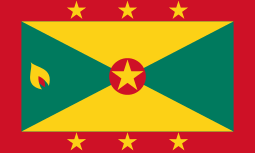People's Revolutionary Government (Grenada)
| People's Revolutionary Government of Grenada | ||||||||||
| ||||||||||
| Anthem Hail Grenada | ||||||||||
 | ||||||||||
| Capital | St. George's | |||||||||
| Languages | English | |||||||||
| Government | One-party Marxist-Leninist socialist state under constitutional monarchy | |||||||||
| Queen | Elizabeth II | |||||||||
| Governor-General | Paul Scoon | |||||||||
| Prime Minister | Maurice Bishop | |||||||||
| Historical era | Cold War | |||||||||
| • | Established | 13 March 1979 | ||||||||
| • | Disestablished | 25 October 1983 | ||||||||
| Currency | East Caribbean Dollar | |||||||||
| ||||||||||
The People's Revolutionary Government (PRG) was proclaimed on 13 March 1979 after the New Jewel Movement overthrew the government of Grenada in a revolution. The government suspended the constitution and ruled by decree until it engulfed into civil war and was removed by a United States military intervention on 25 October 1983.
History
The New Jewel Movement (NJM) under the leadership of Maurice Bishop was the main opposition party in Grenada during the 1970s. In 1979, the NJM overthrew the government of Eric Gairy, which had ruled the country since independence in 1974. The NJM launched an armed takeover of the radio station, police barracks and various other key locations in Grenada while Gairy was on a trip outside the country. The armed takeover was conducted by the People's Revolutionary Army (PRA), which had been formed in secret within the NJM.[1]
The NJM suspended the constitution and announced new laws. Maurice Bishop announced the formation of the PRG over radio, which organized a cabinet to run the country with Bishop as prime minister. All political organizations except for the NJM were banned, and membership in the NJM was thereafter tightly controlled.
The PRG established close relations with the government of Cuba, and with Cuban assistance began construction of a large international airport. The PRG also began a plan to build up the police force on the island.
In 1983, internal divisions occurred within the central committee of the PRG. A group led by Deputy Prime Minister Bernard Coard attempted to convince Bishop to enter into a power-sharing agreement with Coard. Eventually Coard placed Bishop under house arrest and took control of the PRG government. The removal of Bishop led to large popular demonstrations in different areas of the country. In the course of one of these demonstrations, Bishop was freed by the crowd. In unclear circumstances Bishop eventually reached the police headquarters at Fort Rupert.
A police force from another location was dispatched to Fort Rupert. Fighting broke out between that force and the civilians at Fort Rupert resulting in many deaths. Afterward, Bishop and seven others including several cabinet ministers were rounded up and executed.
After the executions, a new government called the Revolutionary Military Council, led by General Hudson Austin, was formed to rule the country and the PRG ceased to exist. This government nominally ruled for six days before being ousted by the U.S. invasion of Grenada.
References
- ↑ Russell Crandall, Gunboat Democracy: U.S. Interventions in the Dominican Republic, Grenada, and Panama (Oxford, UK 2006), 126.
